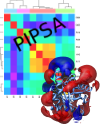

You may also download the original PIPSA code, including a python wrapper called multipipsa. This allows to run PIPSA analysis on multiple sites of the protein and also provides comparative analysis of the binding properties of user-defined groups of proteins. See also the references page.
Start a PIPSA analysis (input PDB format coordinate files).
Start a PIPSA analysis (input SWISSPROT entries with EC annotation)*.
* This type of analysis involves a protein structural modelling step utilizing Modeller. Therefore this part is subject to the Modeller license conditions. Please obtain a Modeller license to use this service.To see the history of changes follow this link.
This open source software was developed in part in the Human Brain Project funded from the European Union's Horizon 2020 Framework Programme for Research and Innovation under Specific Grant Agreements No 720270 and No. 78907 (Human Brain Project SGA1 and SGA2).
For additional information on funding and acknowledgments, please go to our funding page
PIPSA is a tool made available by the MCM group of Rebecca Wade at HITS gGmbH.
In case you need help or have any comments regarding the tool, please contact:
mcmsoft(at)h-its.org